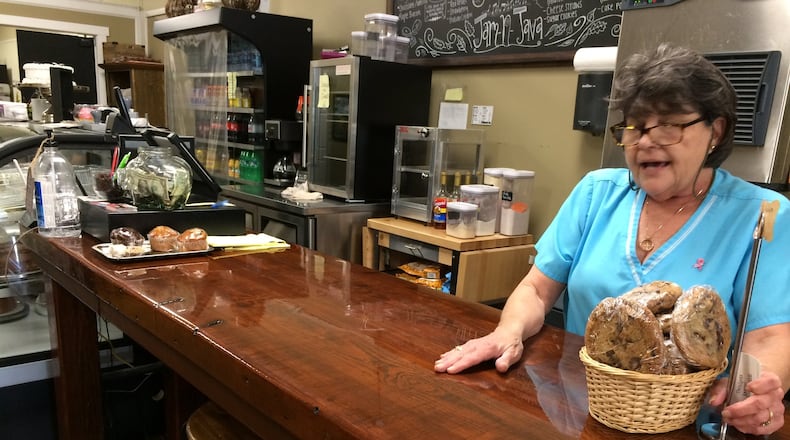Rebba Storey slid a cup and a blueberry muffin across the smooth, maroon counter at the Jam-N-Java Bakery, smiling at her only customer on a recent sunny afternoon.
She skated a hand across the shiny top, pointing to cuts in the dark-stained surface, notches long ago seared into the wood that were later sanded and shellacked.
“This was part of Lanett Mill,” Storey said.
That plant wasn’t far away — at least, what was left of it. Less than a mile away from where Storey was working, a wing of the Lanett factory still crouched, its shattered, skeletal frame casting shadows toward the rubble below.
This small town of 3,700 on the Alabama border is emblematic of the way international trade has helped shape many communities — for better or for worse.
Once home to a thriving textile sector, West Point suffered when most of its mills shuttered. But the tariff-cutting North American Free Trade Agreement — NAFTA — also helped spur new factories, including a 3,000-worker auto assembly plant churning out Kia vehicles.
That leaves some Georgians cheering the idea of change — or even an end — to NAFTA, hoping revisions could repair the damage done. It also spurs fears by those who say the deal has been good overall to the state.
The question is not theoretical. President Donald Trump is mulling whether to stay in the 23-year-old agreement, renegotiate it or rip it up entirely. With negotiators from the U.S., Canada and Mexico sitting down this week for the latest round of talks, the stakes are high.
Ending the current agreement could have a profound impact on Georgia’s economy, which good or bad has reorganized itself around the deal, from its agriculture sector to manufacturing and logistics.
‘Winners and losers’
While NAFTA remade much of Georgia’s economy, it can be hard to pinpoint.
Overall, trade has boomed. The agreement helped provide incentives to create tens of thousands of new jobs in transportation, shipping, warehousing and delivery.
At the same time, employment in some industries was decimated, which badly wounded surrounding towns. Like West Point. Like textiles.
The textile industry includes many kinds of workers — designers, printers, cutters, sewers, wholesalers, truck drivers — but at its heart is the factory worker. Georgia now has about 19,300 jobs in textile mills. That is down 60.5 percent from the start of 2001, according to the U.S. Bureau of Labor Statistics.
“As always, what happens in trade is that you have winners and losers,” said Atlanta-based economist Michael Wald, formerly of the U.S. Labor Department.
Georgia had many winners. For instance, NAFTA spurred job creation in poultry, which geared up to meet increasing demand from Mexico. The tariff-free North American market also encouraged opening certain kinds of factories.
The automotive business, for example, could buy some parts in low-cost Mexican factories, assemble them with high-productivity U.S. workers and sell them in Canada, the United States or Europe.
Yet, in many areas hurt by NAFTA, hiring by the winners did not make up for lost mill jobs.
In the Jam-N-Java, Storey remembers how textiles employed thousands. Factories were the economy’s sinews and connecting tissue, too.
“The week of July Fourth, everything was closed — all the mills — and it was like a vacation week for the whole town,” Storey said.
Her grandfather came down from North Carolina to help with the mills, moving his family, too. Then he was killed in an accident, just walking to work. His wife kept working in the mills.
“Later, a spool came off a machine and blinded her,” Storey said. “She was left with seven children and no husband. But 30 or 40 years ago, you knew that the people in the mill would take care of you.”
‘New set of losers’
Trump won the GOP nomination and later the White House on a protectionist trade platform. He broke with decades of GOP economic orthodoxy, saying that past trade deals hurt American workers. Trump vowed to pull out of the 12-nation Trans-Pacific Partnership — which he swiftly did following his inauguration — but he has dithered on NAFTA.
To commemorate his 100th day in office, Trump moved to terminate the agreement. Then he demurred after a few members of his Cabinet, including Agriculture Secretary Sonny Perdue, a former Georgia governor, reportedly used a map to illustrate how exiting the deal would economically hit his political supporters the hardest.
Later, Trump revived threats of withdrawing from NAFTA — or at least overhauling it.
“If we can’t make a deal, it’ll be terminated and that will be fine,” Trump said following a recent meeting with Canadian Prime Minister Justin Trudeau.
Renegotiating the deal — or ripping it up — would help some businesses, but few expect it to reverse history and rejuvenate the textile industry — especially when experts say many jobs were lost to technology, not cheap labor.
Moreover, in places hurt most by NAFTA, communities are living with — and building on — the status quo. Ripping up NAFTA might create some opportunities, but it would also shake the underpinnings of current growth.
“The damage is already done, but say, you scrap NAFTA and put up barriers, you have a whole new set of losers,” Wald said. “I think immediately of auto manufacturing because some of those parts go back and forth three and four times across the border.”
Despite the stereotype of factory-killing NAFTA, the current economic ecology has helped make a success of the Kia auto plant, a $1.1 billion investment 4.4 miles from downtown West Point.
Hardly any of the 3,000 workers had previously worked in the automotive sector — many had worked in textiles — said Stuart Countess, the chief administrative officer for Kia Motors Manufacturing of Georgia.
But after state-subsidized training, they churn out cars 24 hours a day, making up to $24.36 an hour after three years on the job.
The massive plant has been in operation since 2009, having built 2.5 million cars while playing by NAFTA rules.
About 70 percent of the content used to build vehicles at Kia comes from the three NAFTA countries, Countess said. “If you pull out of NAFTA, anything you bring in from Canada or Mexico will be subject to tariffs.”
Those fees would likely add to the cost of vehicles.
Export businesses in Georgia are also NAFTA winners. For example, the manufacturers of Blue Bird buses in Fort Valley and Gulfstream jets in Savannah. In 1990, the state had 33,100 jobs in transportation equipment manufacturing, according to the Bureau of Labor Statistics.
Chicken and blueberries
NAFTA has been nothing short of a boon for the state’s largest economic sector: agriculture.
Georgia’s agriculture exports to Canada and Mexico more than doubled — from $300 million to more than $716 million — between 2004 and 2016, according to federal numbers crunched by the Georgia Farm Bureau.
The agreement has been particularly beneficial for poultry, the state’s largest ag export, as well as the corn and soybean farmers whose crops go into chicken feed. Georgia’s broiler chicken exports to Mexico have more than sextupled since 1994, the year NAFTA went into effect, according to data from the U.S. Department of Agriculture, and now generate some $74 million annually for the state.
Poultry advocates want to keep NAFTA. They fear that Mexico could impose retaliatory tariffs on the U.S. if Trump ends the agreement. That would mean more chicken stays in the U.S. market, reducing prices and profitability for farmers.
“The worst-case scenario would be that Mexico would want to punish the U.S. by restricting access if they know that they can get product from other countries instead,” said James Sumner, the president of the Stone Mountain-based USA Poultry and Egg Export Council.
It would be very difficult for U.S. poultry farmers to find another market to match the $1 billion-plus appetite Mexico has generated in recent years, Sumner said.
While NAFTA has undoubtedly benefited Georgia poultry, its hasn’t been gravy for all farmers.
Producers from some of the state’s blueberry farms, which dot the South Georgia landscape, say NAFTA has brought down trade barriers to the point where they have a hard time competing with their Mexican counterparts.
Mexico’s longer growing season, lower wages and few regulations — particularly as they relate to wages for farmworkers — have forced prices down in the U.S., making it increasingly hard for Georgia’s producers to recoup their production costs, said Shane Wade, a blueberry farmer near Alma, about 200 miles southeast of Atlanta.
“Within three to four years they’ll be producing more berries than Georgia and Florida put together, and at that time there will be more berries on the market than any other time in the United States,” said Wade, who warns that will push prices down further and cause some farmers to plant other crops or scale back operations.
The state’s timber farmers are also unhappy with aspects of NAFTA, even though many are supportive of the agreement overall.
U.S. producers have been involved in a long-standing conflict with their Canadian counterparts over the softwood lumber coming across the northern border. American producers say they can’t compete with Canada’s heavily subsidized exports, and the U.S. recently imposed punitive tariffs on softwood lumber from Canada.
Blake Sullivan, a Macon-based consulting forester whose clients include former President Jimmy Carter, takes umbrage with NAFTA’s internal dispute resolution system, which he said makes it harder for U.S. timber farmers to legally fight back against unfair trade practices.
“We’re an economic powerhouse and we do try to play fair,” Sullivan said. “But when it goes against one of the fundamental principles of our country, then it’s time to stand up and say, ‘Hey, this is wrong.’ ”
The Georgia Forestry Association, an industry trade group, said Canadian trade practices have translated to less competitive lumber mills and lower timber prices here.
“When landowners can’t make enough money to sustain planting trees and tending them, then the forest starts to degrade and eventually (farmers) can’t make any money at it and they sell and move on to something else,” Sullivan said.
High expectations unmet
About 80 miles southwest of Atlanta and 16 miles from LaGrange, West Point is just one small city in west central Georgia, but it tells a large part of the NAFTA story.
Steve Tramell knows firsthand about NAFTA’s impact.
He’s been in the sewing machine business for 35 years. His company used to sell to factories, mainly in textiles. “NAFTA came along and just killed that part of my business,” he said.
The pain is past. “We have rebounded,” he said. “We are booming now.”
That surge is entangled with his own political identity. He is, after all, the mayor.
He takes pleasure in Kia’s success but says it didn’t really meet the high expectations set after the textile collapse.
“We need more rooftops downtown, for sure,” Tramell said. “We had hoped that when Kia came, we’d get more people in our community, and that didn’t happen.”
The upshot: An area must adapt to handle a massive auto plant, but a manufacturing plant does not mean a surge of local spending. Which means that fuel for economic growth often has to come from elsewhere.
In West Point, when Tramell cites improvements in town — the new businesses and falling vacancy rate — he gives much of the credit to Point University. The school changed its name, moved its campus and brought hundreds of students, faculty and staff to town.
In other words, West Point’s slow trajectory from depression back toward economic health has not been simply a matter of replacing one kind of factory with another. Or one kind of good-paying job with another.
All the pain can’t be blamed on the loss of textiles, not when the overall economy has changed so much. And all the textile loss can’t be pinned on NAFTA, not when technology was eliminating jobs by the barrel.
But textiles were at the heart of many communities, and NAFTA was a body slam to textiles. While time may soften that blow, the pain does endure.
Before she became a barista, Rebba Storey was a human resources manager at a mill owned by Signal Apparel, which closed about 1999, idling 500 workers. It was purchased by an investor, reopened for about a year-and-a-half and then closed again for good.
“We came to work one day and the gate was locked,” she said. “No notice, no checks, no severance.”
As the mill jobs vanished, she tried opening a gift shop. She thought Kia’s arrival would mean good business. It didn’t, and she closed the shop four years ago. Since then, she has lost her husband, her mother and a sister. So she said she sees the closing of the mills through a long lens. “Things were rough,” Storey said, “but you go through it and you just get stronger.”
Which means accepting change, but also grasping the past.
She taps the counter, the one that came from the mill. She points to the places in the wood where workers parked burning cigarettes while they sipped coffee, worked or talked.
“We never thought that the mills would close,” she said.
Keep Reading
The Latest
Featured




